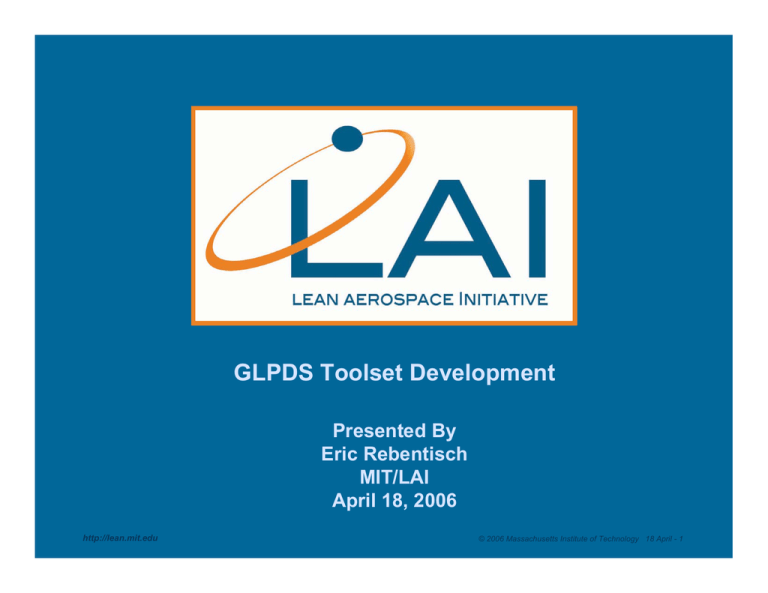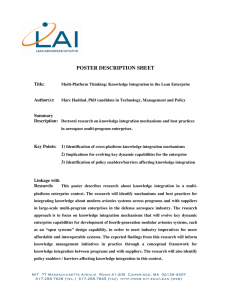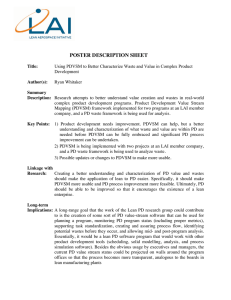GLPDS Toolset Development Presented By Eric Rebentisch MIT/LAI
advertisement

GLPDS Toolset Development Presented By Eric Rebentisch MIT/LAI April 18, 2006 http://lean.mit.edu © 2006 Massachusetts Institute of Technology 18 April - 1 Lean Product Development System Framework? • • • Book released in April 2006 Extensive case study of Toyota Product Development processes and system Toyota Performance: • Industry-leading profits • Top-performer in J.D. Powers quality • • • http://lean.mit.edu survey Among lowest R&D$ to sales ratio in autos 12-15 month cycle times—average age of offerings is ~1/2 of competitors The case to study for Lean PD for LAI? © 2006 Massachusetts Institute of Technology April 18 - 2 13 Principles of the TPDS Process: 1. Establish customer-defined value to separate value2. 3. 4. added from waste Front-load the PD process to explore thoroughly explore alternative solutions while there is maximum design space Create leveled product development process flow Utilize rigorous standardization to reduce variation, and create flexibility and predictable outcomes Source: Morgan, James and Jeffrey Liker, “The Toyota Product Development System”, Productivity Press, 2006, p. 18 http://lean.mit.edu © 2006 Massachusetts Institute of Technology April 18 - 3 13 Principles of the TPDS, cont. Skilled People 5. Develop a chief engineer system to integrate development from start to finish 6. Organize to balance functional expertise and crossfunctional integration 7. Develop towering technical competence in all engineers 8. Fully integrate suppliers into the product development system 9. Build in learning and continuous improvement 10. Build a culture to support excellence and relentless improvement Source: Morgan, James and Jeffrey Liker, “The Toyota Product Development System”, Productivity Press, 2006, p. 18 http://lean.mit.edu © 2006 Massachusetts Institute of Technology April 18 - 4 13 Principles of the TPDS, cont. Tools and Technology: 11. Adapt technology to fit your people and process 12. Align your organization through simple, visual communication 13. Use powerful tools for standardization and organizational learning Source: Morgan, James and Jeffrey Liker, “The Toyota Product Development System”, Productivity Press, 2006, p. 18 http://lean.mit.edu © 2006 Massachusetts Institute of Technology April 18 - 5 PD System A Customer transmits new need to developer • • • Developer designs product to meet need Developer delivers product to customer Customer uses product until it no longer meets needs Limited duplication of products competing to address the same need—often only one Developer often acquires full capability to meet current customer need only after it is expressed Product delivered when and where specified by the customer, although with variation in actual delivery performance http://lean.mit.edu © 2006 Massachusetts Institute of Technology April 18 - 6 PD System B Developer forecasts customer needs Developer designs product to meet plan Developer delivers product to customer Customer uses product until it no longer meets needs • Significant duplication of products competing to address the same need, each with many of the same characteristics • Forecasts of customer needs determine developer PD strategy and new product introduction timetable • Developer delivers products in a way that benefits and develops its PD capabilities • Product developed on a regular basis to well-defined timetable; customers take deliveries of new products from inventory http://lean.mit.edu © 2006 Massachusetts Institute of Technology April 18 - 7 Lean in PD? • • • Which development system is more lean? • System A? • System B? What real-world organizations do these caricatures represent? • Do you believe it? What does this mean for LPDS for LAI members? • Different product architectures? • Different technical readiness levels defined by customer value? • Fewer roles for derivatives? http://lean.mit.edu © 2006 Massachusetts Institute of Technology April 18 - 8 More Insight into the Toyota Lean PD System Performance • 12-15 month product development cycle leads the industry • But, this is for derivatives based on established platforms • • What about new platform development cycle times? • Lexus: 6 years • Prius: 4 years (for a crash program) How does this compare to aerospace products of greater cost and complexity? • Examples of derivatives based on established platforms • delivered in 12-24 months Systems costing ~3 orders of magnitude more than a Lexus and requiring significantly more demanding safety testing http://lean.mit.edu © 2006 Massachusetts Institute of Technology April 18 - 9 Translating from Toyota to PD Systems With Different Product Architectures • Toyota LPDS practice Example: 2. Front-load the PD process to explore thoroughly explore alternative solutions while there is maximum design space • • Typically manifest as set-based concurrent engineering with the development of multiple prototypes for specific subsystems (typically derivatives) LAI research analog: • Multi-attribute tradespace exploration—allows the rapid exploration of massive tradespaces of new product platforms • http://lean.mit.edu Parametric modeling based on known attributes of subsystems © 2006 Massachusetts Institute of Technology April 18 - 10 A GLPDS? • Most of the actual practices employed in Toyota’s lean PD system have been used in aerospace PD at one time or another • A number were “borrowed” originally from aerospace • Many have been investigated and documented in LAI research in the aerospace context • • Is it sufficient to map the aerospace analogs of these “best practices”? How to best address the gap between knowing and doing? • The choices for product architecture/strategy that Toyota • • has made enable it to develop and exercise a PD culture that enables continuous learning Can this be implemented in the Aerospace context? Is this a useful area to focus efforts? http://lean.mit.edu © 2006 Massachusetts Institute of Technology April 18 - 11



